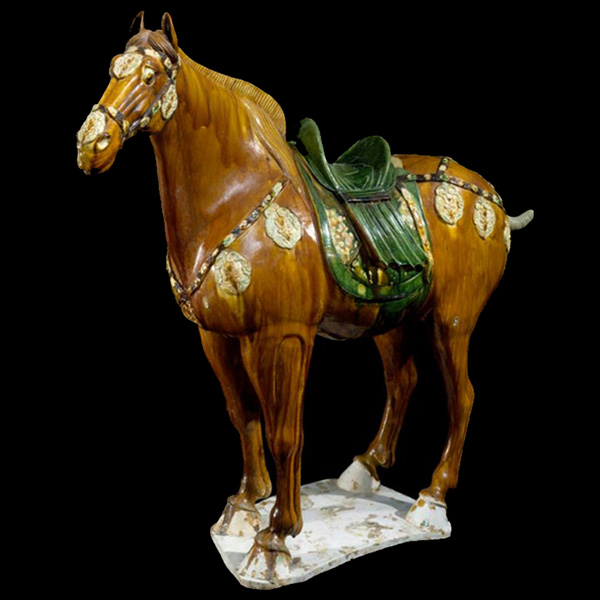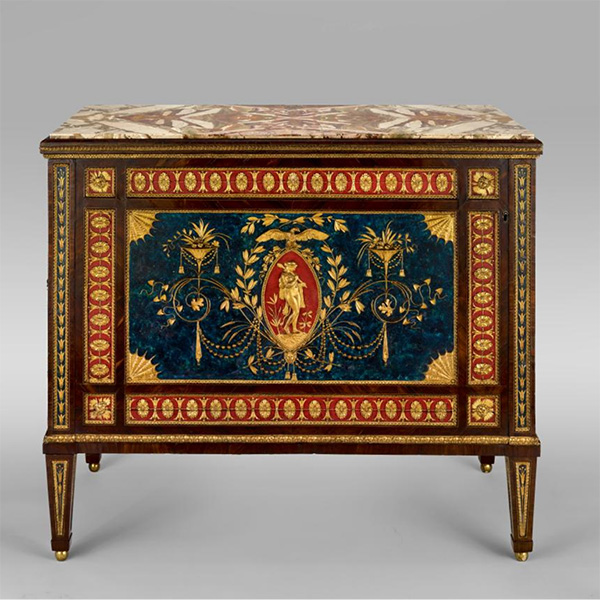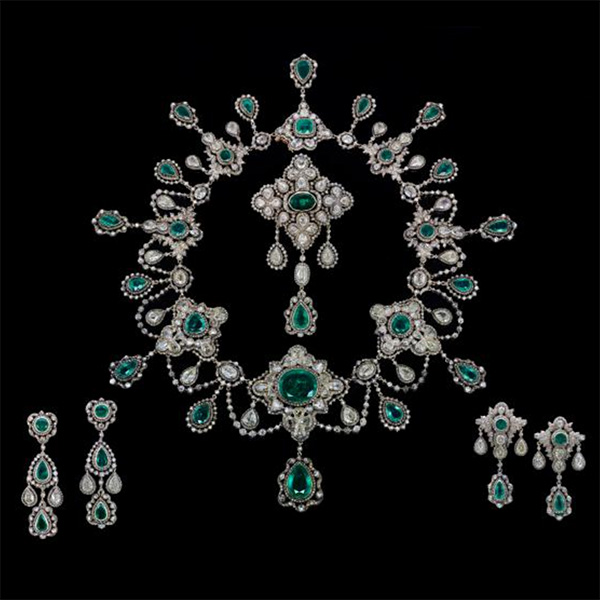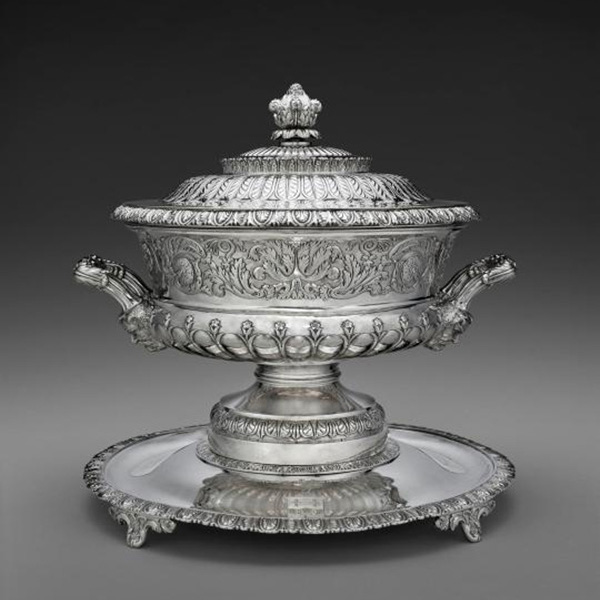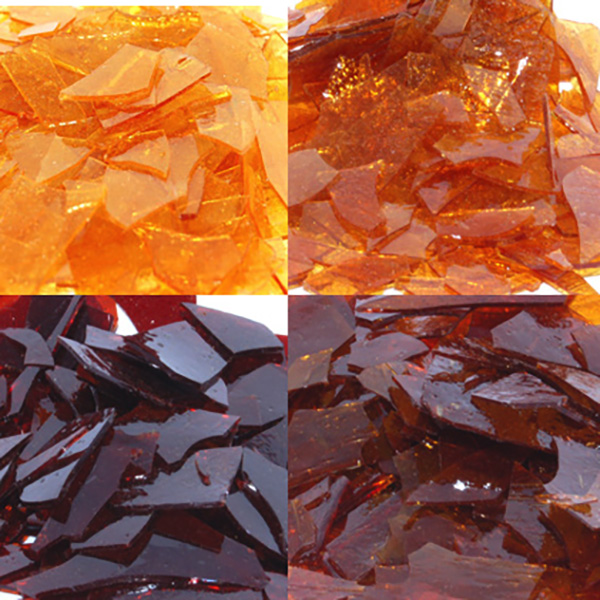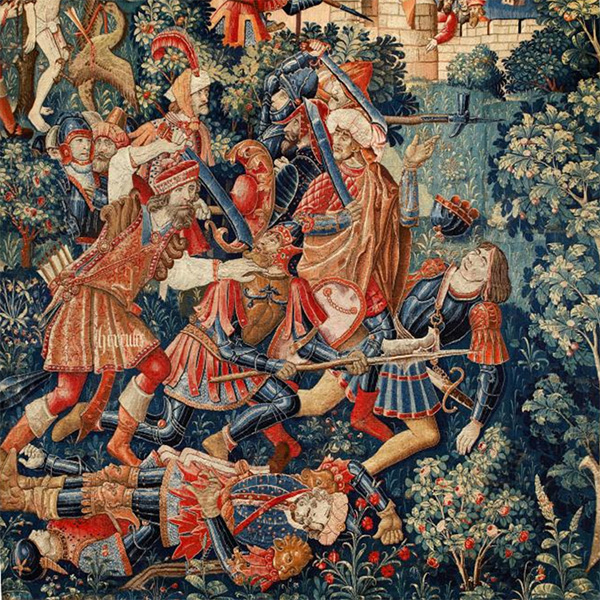The Chemical Components of Wood
Wood is based on a complex cellular structure composed of cellulose (see Textiles), to provide structural stability, and other components including hemicellulose, pectins, lignins and other extractives. Similar to cellulose, hemicelluose and pectins are also made up of sugars but they contain other sugars besides glucose. Sugars are carbohydrates. They got their name originally because the empirical chemical formula is a 1:1 combination of carbon and water: [C·(H2)O]n. Those with a formula with n = 5 are known as pentoses and those with n = 6 are hexoses. The common pentoses include arabinose, lyxose, ribose and xylose, while the hexoses are allose, altrose, glucose, mannose, gulose, idose, galactose and talose.
A casual glance a the structures of the sugars may make you think that they are all the same, but they are structurually distinct. For example, the non-cyclic forms of the hexoses may be written as [H-C(=O)-C(H)(OH)-C(H)(OH)-C(H)(OH)-CH2OH. The four carbons in the middle of the molecule each have four different groups attached to them. This means that these groups are chiral and, therefore, each has two different orientations (See Organic Structures. So even if they appear to be the same, they are all structurally different. The total number of possible hexoses will be given by (2)4, or 16. By analogy, there will be 8 (23) possible pentoses.
Of course, as these sugars become linked together, water is lost and the formula no longer has a ratio of one carbon for one molecule of water. The simple sugars tend to react with themselves to form ring structures, which are the forms most commonly found in nature. Some sugars that are commonly found in hemicellulose and pectins include β-D-xylopyranose (xylose), β-D-glycopyranose (glucose), β-D-mannopyranose (mannose), 4-O-methyl-glucopyranosyluronic acid, L-arabinofuranose. The term pyranose indicates that the sugar is in the form of a six-membered ring, while a furanose has the sugar forming a five-membered ring structure.
In contrast, lignins are phenolic polymers as described below.
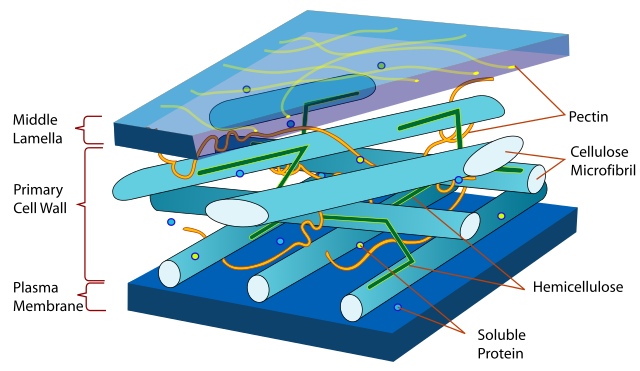
Some sugars found in hemicelluloses and pectins.
Hemicelluloses
As the name implies, hemicellulose is similar in structure to cellulose but is composed a smaller number of random sugar units, usually on the order of a few hundred in comparison to cellulose which has a few thousand sugar units. Its structure is amorphous as compared to cellulose, which is crystalline, and hemicelluloses are much more easily hydrolyzed in dilute acid or base or by a number of specific enzymes known as hemicellulases. Hemicelluloses are embedded in cell membranes and bind to pectins to help hold the cells and the cellulose structures together (See the plant cell diagram above).
Pectins
Pectins are heteropolysaccharides, which means that they are made of several different types of sugars or sugar deriatives. The main component of pectins is galacturonic acid, which is an oxidized form of the sugar galactose. The acid nature derives from the carboxylic acid group, -CO2H which replaces the two hydrogen atoms on the CH2OH group in the starting sugar with a doubly-bonded oxygen atom. The function of pectins is to help bind the plant cells to each other.
Lignins
Lignins are large phenolic polymers with molar masses greater than 10,000 u. That designation comes from the compound phenol, which contains an aromatic ring bonded to a hydroxy group (-OH). Molecules with a -OH group attached belong to the general class of organic molecules known as alcohols. The most common monomers that get polymerized are derivatives of paracourmaryl alcohol which has a hydroxy-propenyl group (-C(H)=C(H)CH2OH) on the aromatic ring as well as the simple hydroxy group. Coniferol and sinapyl alcohol have one or two additional methoxy groups, respectively These are attached to the carbon atomns next to the phenol function. As can be seen in the figure for a lignin fragment, the coupling of these different groups is quite complicated and the structures in a given plant will be quite varied. Lignins occupy spaces in the cell walls of woody plants and connect the cellulose, hemicelluoses and pectins to produce the overall rigidity associated with wood.
Extractives
In addition to cellulose, lignins and hemicellulose, woods contains low molecular weight organic compounds known as extractives. Most of these are lipophilic (nonpolar) and can be extracted from the wood by the use of organic solvents like acetone, with only a small part being water soluble. The lipophilic extract is also known as wood resins and contains fats, fatty acids, sterols, steryl esters, terpenes, terpenoids, and waxes in addition to free sugars that are the constituents in cellulose and hemicellulose. We have already encountered fats and fatty acids as these are the sources of the drying oils used in paintings.

Terpenes are naturally-occuring hydrocarbons that are based on isoprene, C5H8, which is the building block for many naturally-occuring molecules besides the terpenes. Terpenes are multiples of isoprene with formulas of [C5H8]n, while the terpenoids are derivatives of the terpenes that contain other functional groups, primarily those based on oxygen. α-(-)-Pinene and α-(+)-pinene are examples of terpenes. Natural rubber is a polymer of isoprene. Steroids and sterols are produced biologically from terpenoid precursors. Eucalyptol, the fragrant component of eucalyptus oil found in the leaves of Ecalyptus globulus, is an example of a monoterpenoid. Abietic acid is a primary component of the resin acids found in pine trees.
Since lignin contain phenolic compounds, it is not surprising to find small molecule phenolic compounds in trees. The phenolic compounds are polar and can exhibit hydrogen-bonding and, consequently, are not usually found in the resin. One example is pinoresinol, which is found in hardwood and bark. It is a coupling product two molecules of coniferol that is a component of lignin as discussed above.
There are are numerous extractive compounds, so they can't all be listed here. You can find more examples at Wood on Wikipedia.
The Macroscopic Properties of Wood
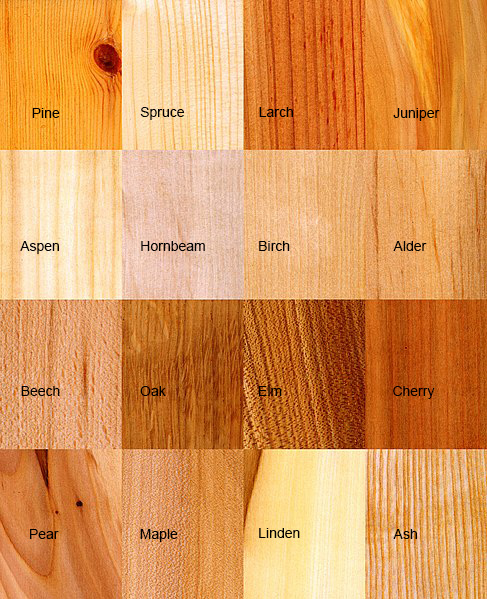
The macroscopic organization of plant cells, cellulose, hemicelloses, pectins, lignins and extractives leads to structural stability associated with trees. The longitudinal cells are organized in bundles along the growth direction, similar to a bundle of drinking straws, providing a conduit for water and nutrients to travel up the trunk of the tree to reach the uppermost branches and leaves, while ray cells periodically run perpendicular to the growth direction to add lateral stability. The result is the different colors and grain patterns that we associate with wooden, and woodworkers choose the type of wood specifically to the desired properties in the final object based on color, grain, availability and expense.
The various types of the components also produce woods that are hard woods or soft woods. Hard woods generally grow more slowly and resistant to scratching and denting, while soft woods grow more quickly and are easily scratched and dented. As a result, hardwoods are more expensive than softer woods. Hardwoods most often are deciduous trees and include mahogany, teak, purple heart, walnut, oak, ash, elm, aspen, poplar, birch, maple and cherry. Conifers, which grow only in the northern hemisphere, produce mostly softwoods. These include pine, spruce, cedar, fir, larch, etc. The hardwoods are often more deeply colored than the softwoods.
Because trees are made of living cells, freshly cut wood has a very large fraction of water, ranging up to about two-thirds of it mass. In order to be used, wood has to be dried carefully to reduce the moisture content. If the drying process is carried out too quickly, the wood will warp or crack. Wood boards can be carefully stacked and air dried, a process that can take months or even years depending on the size of the boards. Kilns can also be used to dry to the boards more quickly. After drying, the boards will contain 8 to 25% water by weight, and that moisture content is dynamic. Even after the wood is made into something, the moisture content of the wood will continue to change with the relative humidity in the surroundings. Quick changes in humidity can lead to cracking and warping, and many antiques that have been stored in un-air conditioned spaces will undergo significant damage if suddenly moved to a dryer or more humid climate. Sometimes that cracking and warping can be catastrophic - the boards in a piece of furniture may be held tightly in placed so that the formation of a crack can release a tremendous amount of tension. Woodworkers are able to design furniture so that some pieces 'float' inside a frame (for example, an inset paneled door) and thereby have some freedom on expansion/contraction that reduces the amount of stress.
Shaping Wood
In comparison to stone and metal, manipulating wood is comparatively easy. It can be cut, scraped, planed, sawn, drilled, carved and turned on a lathe. Specialized tools have been used for centuries, with some styles being characteristic of particular cultures. The ways in which wood is fashioned need to take into account the grain of the wood in order to achieve strength and minimize warping and cracking due to expansion and contraction resulting from changes in humidity. As anyone who has split wood for a fire knows, a tree is most easily split down the growth direction, so the placement of the grain direction of a piece of wood within an object is an important consideration for achieving maximum stability. Wood has its maximum compressive strength along the direction of growth, so normally supporting pieces such as legs will be aligned in the same direction.
The fitting of pieces of wood into furniture is known as joinery. Those who build furniture or work with wood are known also as joiners in addition to being referred to as carpenters or woodworkers. The word joinery emphasizes the process of designing the joints holding wood together are designed. While using nails and screws is common in woodworking in modern times, metal was more rarely used in the past owing to its scarcity and cost. The oldest wooden objects would be fitted together only by designing joints that would reduce the need for other materials. These joints would often be stabilized by addition of glue, but in the most carefully designed objects even glue was not necessary. While it is not possible to cover all of the types of joints here, a few examples are given to illustrate the logic in design.
The choice of the lumber is important to the serious craftsman. If boards are already prepared, they must be straight in all directions without signs of warping or cracking. Knots in wood can be a desirable decorative feature or they can be weak spots that one would want to cut out in making the final piece. If boards are to be pieced into a larger flat object such as a door or table top, consideration will be given to using similar the grain pattern. A pleasing effect, known as bookmatching, is obtained by mirroring grain direction by using boards cut from the same section of a tree.
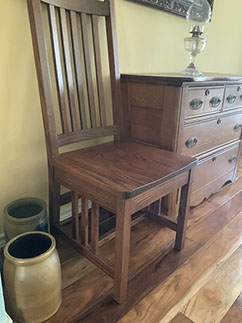


The ring structure of trees is well-known. Growth occurs on the outside of the tree in the growing region known as the sapwood that is responsible for transporting water and nutrients to the upper parts of the tree. The inner wood is known as the heartwood, which surrounds a center known as the pith. Concentric rings form with each growing seasons so that a ring, which is seen as an alternation of lighter and darker areas, corresponds to a year's growth. The age of trees can be determined and the sizes of rings can be associated with the growing conditions in particular years. The heartwood often contains knots, which is the residue of branches that have broken off as the tree has grown.
The ring structure of trees poses challenges for creating uniform flat boards. as can be seen in the figure, the grain is markedly different depending on whether boards are cut in a plain sawn, quarter sawn or rift sawn method. Plain sawn is the easiest and less expensive method but produces boards that have very different grain directions. The quarter saw method produces more uniform grain directions but is inefficient in the use of the wood. Rift saw has the most uniform grain directions but is also the least efficient in utilization of the wood.
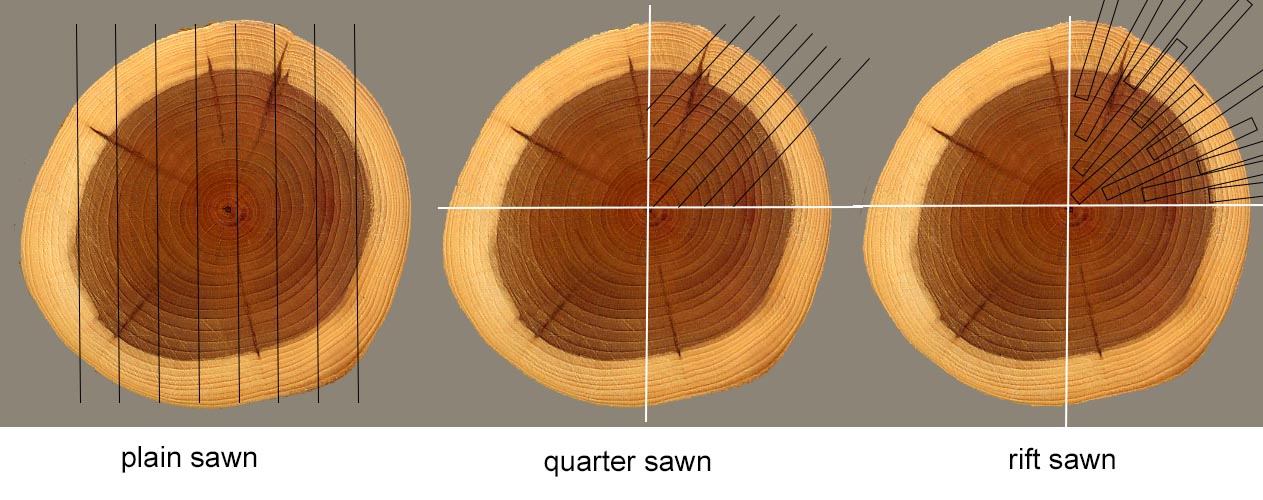
The figures below show how different cuts of a tree will result in different amounts of shrinkage and warping. Shrinkage is greater along the ring directions and less perpendicular to the rings. In choosing boards for placement in furniture, the woodworker will note the grain directions in a board and match those to the location in the object being made.

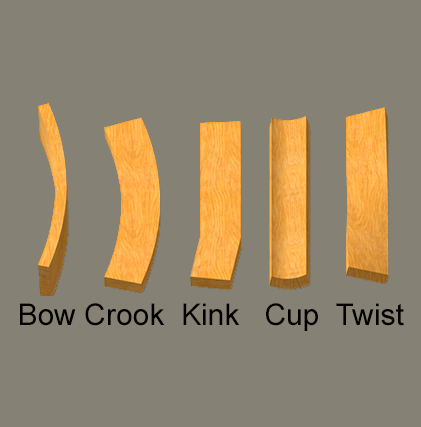


Bent wood
After steaming or soaking in water, wood can be bent into the desired shape and allowed to dry, although there are limits on how thick the wood can be. Bent wood can also be fashioned from thin, flexible slices of wood that are then glued in multiple layers and clamped to a mold in the desired shape. Once the glue has dried the curved shapes are retained.
veneer
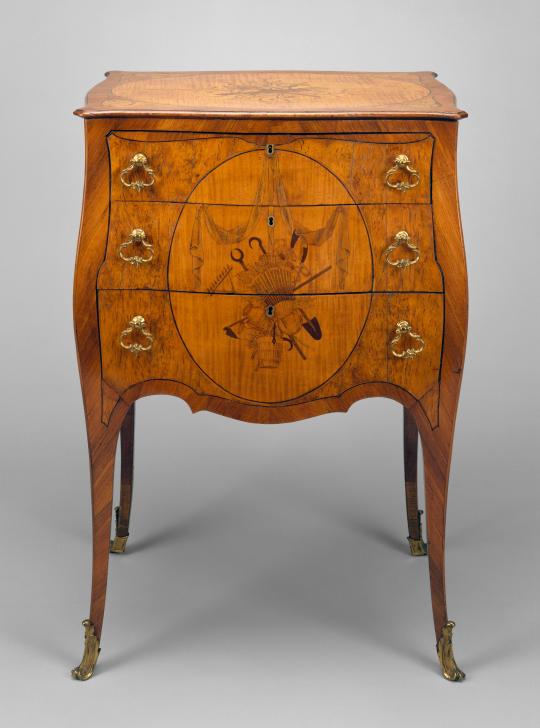
To cut down on the use of more expensive types of wood, woodworkers would cut very thin sheets of the most expensive varieties and use adhesive to bind these to the surface of wooden objects made of cheaper materials. The technique allows for the creation of elaborate designs using multiple types of woods with different grains and colors. A problem with veneers is that they can begin to peel off of the layer underneath in conditions of high humidity. Veneers are also subject to chipping around the edges.
plywood and composites
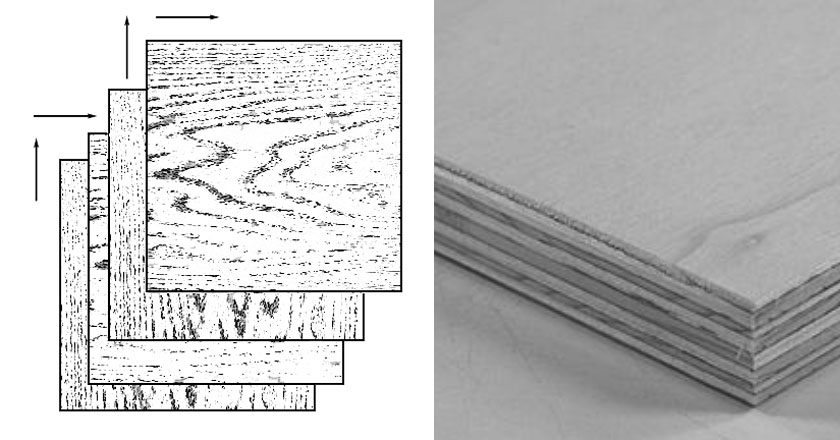
Plywood is created by laminating thin layers of wood in alternating grain directions. As a result, plywood has enhanced strength and stability and reduced expansion/contraction and it is generally less expensive that solid wood of the same dimensions. In the US, plywood is usually sold in 4' x 8' sheets. Since the different layers are glued to together, plywood is more easily damaged by moisture and the individual layers, known as plies, may delaminate. Plywood may be industrial or building grade with the exposed top and bottom surfaces left in an unfinished state, or the plywood may have a finished surface that is suitable for using directly in furniture building. Plywood also comes in a marine grade that is resistant to water damage.
Particle board or chip board is made of small wood chips mixed with a binder and compressed. It can be covered with a veneer, which can be wood or plastic, for finished uses. Particle board is very inexpensive but it is very susceptible to water damage. Low cost furniture and shelving is often made of particle board.

With a renewed emphasis on creating environmentally friendly buildings, architects and building firms are increasingly creating structures using cross-laminated timber (CLT). CLT is created on the same principle as plywood in having alternating layers, but the layers are substantially thicker. The use of CLT is a method both for sequestering carbon in a longlasting structure as well as reducing carbon dioxide emissions by reducing the use of concrete, which is one of world's largest CO2 producing industries because it derives from heat processing calcite (CaCO3). CLT, even though it is made of wood, has a low burn rate. CLT has the added advantage that it can be prefabricated - processed offsite and transported to the building location with many features of the structure already prepared (e.g. locations already cut or drilled for doors, windows, plumbing, electrical wiring, etc). This also produces significant safety advantages when high rise buildings are being built as more of the prep work can be done in a factory at ground level. Even multistory structures can be built with this technology. The Mjøstårnet building completed in March 2019 was 85.5 meters (280 ft) tall, making it the world's tallest all CLT building. CLT buildings are quite attractive owing to the use of the natural wood grains and colors.

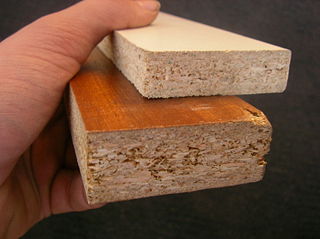

Shortcuts
Resources and References
Structure Data
Structures were obtained from the PubChem database and images created using ChemDoodle3D (2007-2021) iChemLabs, LLC and/or CrystalMaker 10, 1994-2920 CrystalMaker Software Ltd.
Credits for the Header Image
- Chest on Chest, unknown American, 1760-1800, Mahogany, Atlantic white cedar, yellow poplar white oak and southern yellow pin, Bayou Bend Collection, Museum of Fine Arts Houston, Public Domain.
- Side Chair, James Graham, Scottish born American, ca. 1755-1775, Mahogany, soft maple and red oak, The Bayou Bend Collection, museum purchase funded by the Theta Charity Antiques Show and the Lora Jean Kilroy Accession Endowment, Museum of Fine Arts Houston, Public Domain.
